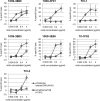Complement-dependent lysis of influenza a virus-infected cells by broadly cross-reactive human monoclonal antibodies
- PMID: 21994454
- PMCID: PMC3233150
- DOI: 10.1128/JVI.05193-11
Complement-dependent lysis of influenza a virus-infected cells by broadly cross-reactive human monoclonal antibodies
Erratum in
- J Virol. 2012 Feb;86(3):1901. Wrammert, Jens [added]
Abstract
We characterized human monoclonal antibodies (MAbs) cloned from influenza virus-infected patients and from influenza vaccine recipients by complement-dependent lysis (CDL) assay. Most MAbs active in CDL were neutralizing, but not all neutralizing MAbs can mediate CDL. Two of the three stalk-specific neutralizing MAbs tested were able to mediate CDL and were more cross-reactive to temporally distant H1N1 strains than the conventional hemagglutination-inhibiting and neutralizing MAbs. One of the stalk-specific MAbs was subtype cross-reactive to H1 and H2 hemagglutinins, suggesting a role for stalk-specific antibodies in protection against influenza illness, especially by a novel viral subtype which can cause pandemics.
Figures



References
-
- Fernandez Gonzalez S., Jayasekera J. P., Carroll M. C. 2008. Complement and natural antibody are required in the long-term memory response to influenza virus. Vaccine 26(Suppl. 8):I86–I93 - PubMed
-
- Finco O., Rappuoli R. 2008. Rediscovering complement, the first barrier of innate immunity. Vaccine 26(Suppl. 8):I1–I2 - PubMed
Publication types
MeSH terms
Substances
Associated data
- Actions
- Actions
- Actions
- Actions
- Actions
- Actions
- Actions
- Actions
- Actions
- Actions
- Actions
- Actions
- Actions
- Actions
- Actions
- Actions
- Actions
- Actions
- Actions
- Actions
- Actions
- Actions
Grants and funding
LinkOut - more resources
Full Text Sources
Other Literature Sources

